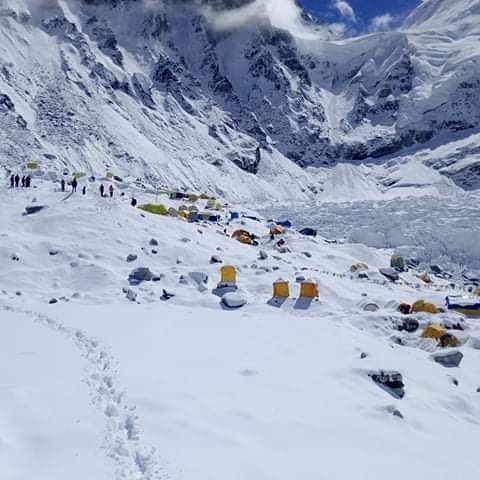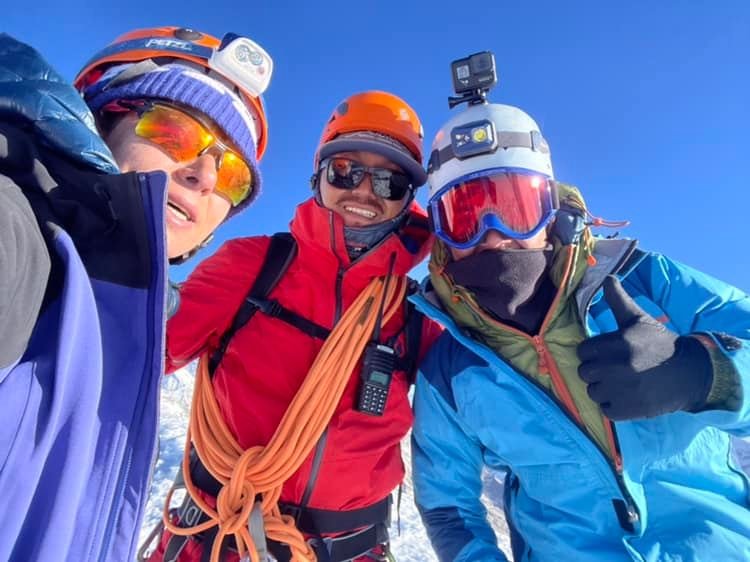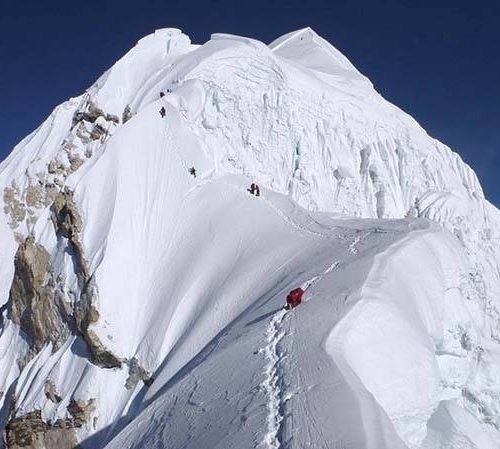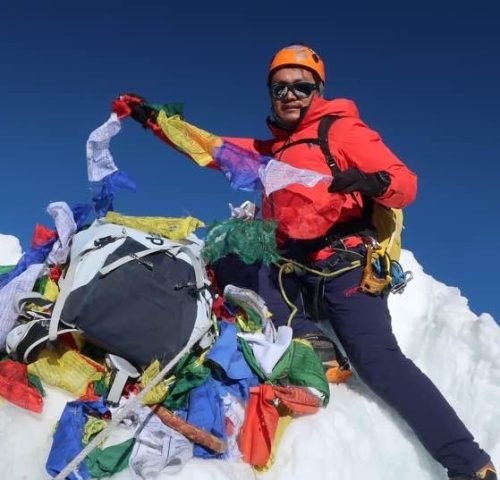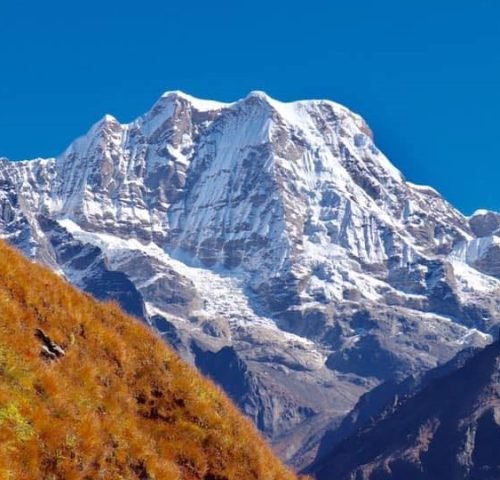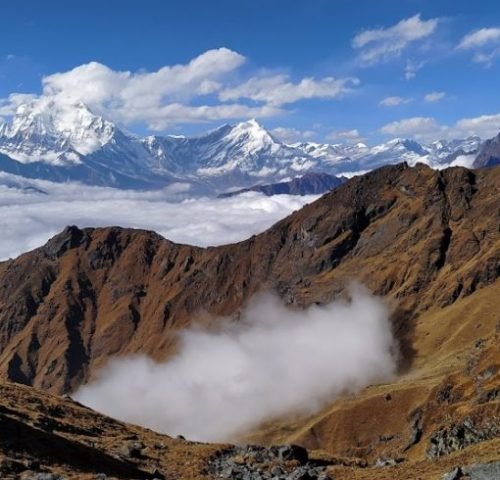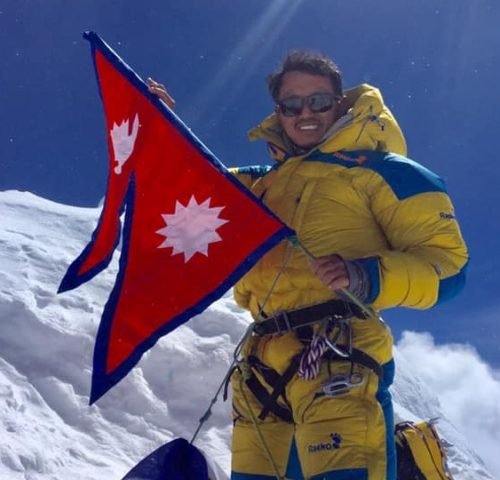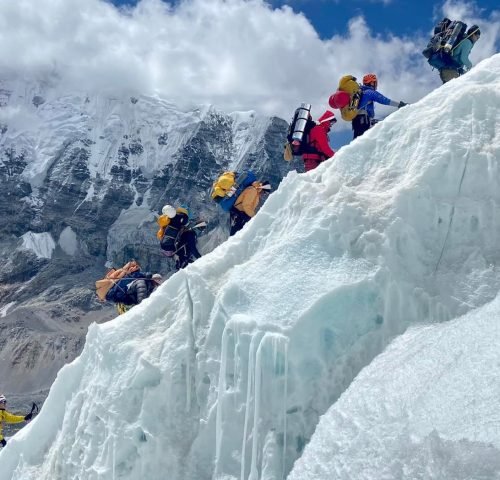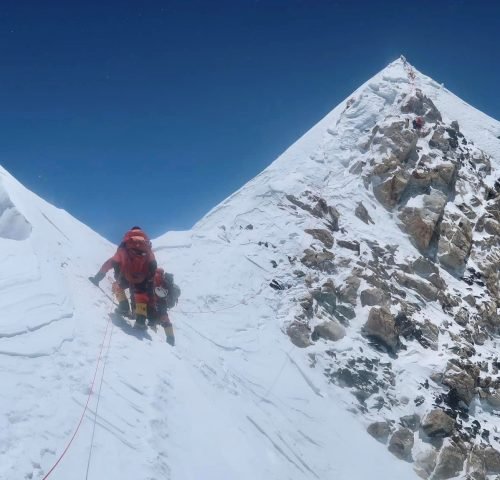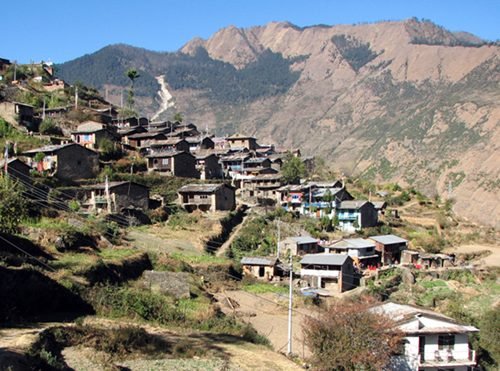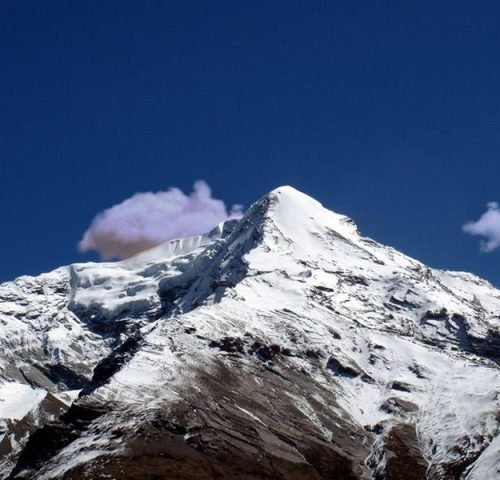Overview
Our Everest expedition itinerary is designed with experience, planned and careful attention allowing maximum days for the approach, the highest level of service and a strong team of guides. We offer expeditions with safety priority and service paramount. We offer more oxygen support and provide comfortable logistics at base camp and Camp 2.
We follow the standard trekking route to Mount Everest basecamp following Lukla Namche Bazar, Tyangboche monastery, Dingboche, Lobuche, Gorekshep and finally Everest base camp. A pre-training session be held at the base camp on ice fall of the Khumbu Glacier to check climbers’ equipment and review climbing and rescue techniques. You will also climb Lobuche east 6100 meter peaks before climb Everest for your acclimatization.
Our second acclimatization phase begins with the rotation of higher camps passing by the notorious Khumbu icefall. Four camps will be set up above the base camp. We will prepare Camp1 (5,900m/19,500ft) at the pinnacle of the icefall, Camp2 (6,400m/21,000ft) in Western Cwm, which will be our Advanced Base Camp. We will set up Camp 3 (7,300m/23,700ft) at the top of the cirque on Lhotse Face. Camp 4 (7,900m/25,912ft) will be the final camp before climbing the summit. Camp 4 will be placed in the South Col.
Your expedition leader will suggest you the best as per your conditions. In general, our acclimatization program includes overnight at Camp 2 and tagging the Lhotse Face/Camp 3. When this is done, we rest and recover at the base camp while waiting for the weather window for the summit attempt. Oxygen cylinders will be used after Camp 3 for an easy ascent. We provide 8 bottles of oxygen to each climber for maximum flow. From Camp 4, following the southeast ridge, we will make it to the South summit from where we will advance towards Hillary step before climbing to the summit.
Details Itinerary
Day 01: Arrival in Kathmandu 1300m and transfer to Hotel.
Our office representatives will welcome you outside the terminal hall and transfer you to the hotel. brief you about tomorrow’s activities and collect any documents required by our office.
Day 02: Expedition Preparation.
On the second day, we will complete all of our formalities, such as getting the required paperwork, permits, and other formalities required for our expedition, and we will begin making preparations for it. We will now prepare our luggage, go shopping, and double-check everything we need (especially medicines and essentials). There will be briefings on every part of the expedition, including all gear and equipment, the length of the trip, lodging options, base camp facilities, and all other aspects related to the expedition. It also gives you the chance to interact with and get to know your climbing companions and colleagues.
Day 03: Fly to Lukla 2800m and trek to Phakding 2600m. ( 3 hours trek)
We take an early morning flight to Lukla, where all Everest treks begin. You will need permission from the locals to continue exploring once you arrive in Lukla. This is the entrance to the protected Khumbu Region. To proceed, you will need the Khumbu Pasang Lhamu Entry Permit. The Trekkers Information Management System card has been replaced with this admission permission. The admission fee goes toward the development of the rural community.
Once you get into Lukla, eat breakfast at the lodge, and prepare luggage for the porters, the walking starts. To get to Phakding, there are a few ups and downs, as well as many prayer rocks (Mani in the local language). After you’ve settled into your Phakding lodge, take a short walk to the village.
Day 04: Trek to Namche Bazar 3340m. (6 hours trek)
Our trail passes through a pine forest, and we continue our walk on the trail that goes north up the Benkar valley. We cross the Dudh Koshi River and pass Chumoa and Monjo villages before reaching the entrance of the Everest National Park. Then, after crossing a suspension bridge, we pass Jorsale village and walk alongside the Dudh Koshi and Bhote Koshi rivers. ascend on a steep trail and reach Namche Bazaar, which is probably the biggest town in the Everest region.
Day 05: Acclimatization day in Namche.
We can tour Namche Bazaar, which is the primary town of the Everest or Khumbu region. We can hike up to the Everest viewpoint hotel and enjoy the sunrise over the Himalayas, including Mt. Everest, Lhotse, Nuptse, Ama Dablam, Thamserku, Kongde, and so on. If we are interested in a day hike, we can trek to Khumjung village. Today we also visit the Hillary School and a monastery that houses a yeti’s scalp.
Day 06: Trek to Dole 4050m (5-6 hours).
Little climb after Namche and walking gradual along side and views with High mountains and after Sanasa climb to Mong La 4010m after down to Phortse Tenga. It is beautiful walk through the Pine and Birch trees may encounter with Musk dear on the way up to Dole above tree line. Overnight at Tea house lodge.
Day 07: Trek to machhermo 4430m (4-5 hours trek)
Walking along the Alpine meadow with Yaks and alpine High land Birds and flowers with Cho Oyu (8,153m) views in the North. This is short walk but altitude wise it is necessary stop at Machharmo. Overnight at Tea house / Lodge.
Day 08: Trek to Gokyo 4800m (4-5 hours trek)
Walk north in to Dhudkosi valley via Fanga. After passing Waterfalls water from Gokyo lakes encounter with first lake, Second lake than third lake Gokyo with surrounded mountains. Over night at Tea house / Lodge.
Day 09: Acclimatization around Gokyo
This is the day for explore round the areas. Wake up early morning to hike up Gokyo ri (5483m) for 360 views including Everest and Makalu. Late morning back to Gokyo and explore for fifth lake and Nagjumba Glacier than back to Gokyo. Overnight at Tea house / Lodge.
Day 10: Trek Thaknag 4740m ( 3 hours trek)
Just 2 hours walking distance over the glacier will take us to Gokyo and we can explore around Gokyo Valley. Overnight at Tea house / lodge.
Day 11: Trek to Zongla 4700m via Chola Pass 5350m (7-8 hours trek)
This is quite long walk about 8 hours where we start early morning with packed lunch and trek uphill and turn east with boulders and steep climbing upto pass. Pass is always with ice, sometimes with deep snow and then walk down to Thangnak. Overnight at Tea house / Lodge.
Day 12: Trek to Lobuche high camp 5400m. (3-4 hours trek)
From Zonglha we trek towards Lobuche base camp then continue to High Camp. The path is steeper and rocky. We enjoy great views of Ama Dablam, Pokalde, Thamserku, Kntega and other mountains. In the afternoon our senior climbing guide will provide training on peak climbing techniques and proper way to use the climbing gears. Overnight at tented camp.
Day 13: Climb Lobuche east 6120m and back to Lobuche (8-10 hours)
Today is the big day you are looking for in the whole trip. We wake up around 1 am and take hot tea/coffee and breakfast. After few hundred meters climbing through the rocky path then climbing on ice and snow. The guide fix a rope when and where it is required. While climbing through the rocky and glacier path fixed rope and man rope both will be used for safety. The summit of Lobuche peak offer one of the most panaromic mountain view than any other trekking peak. After enjoying summit views of Mt. Everest, Lhotse, Nuptse, Ama Dablam, Pumori, Cholatse, Thamserku, Kantega and many more we then descend to the Lobuche village. Overnight lodge.
Day 14. Trek to EBC 5380m (5-6 hours trek )
After the breakfast we walk Gorakshep and we take lunch the continue trek to Everest Base Camp route. Walking in the Khumbu valley alongside of Khumbu Glacier Overnight at camp/tent.
Day 15: Day 15-55 Climbing Period.
Mount Everest South Side Expedition Climbing Period:
After few days acclimatization and observation the Himalayas at the Everest Base Camp, we start up through the Icefall to the Camp1 early morning and return to our more comfortable Base Camp. Our practice leader at Base camp will guide all the members to become familiar with Icefall. We provide our valuable expedition members enough time to be acclimatizing with environment, altitude before we head to Camp3 and Camp4. Our Everest summit plan in general will be a single push on 7-9 days from Base Camp as follows: Everest Base Camp to Camp1, Camp1 to Camp2, Camp2 to Camp3, Camp3 to Camp4 to Summit to Camp4, Camp4 to Camp2, Camp2 to Base Camp and continue walk back to Lukla and fly to Kathmandu. The Summit program will be dependent upon weather and snow conditions.
Everest Base Camp: 5380m
Base camp is situated at the Khumbu Glacier, on active ice which melts during monsoon and camp side moves slightly every year. Our professional base camp Sherpa and helpers manage comfortable camp side. There will be practice ladders at Base Camp so that Members will have the chance to become familiar with how to walk across these before travelling through the Icefall for the first time. We take plenty of time exploring Khumbu Ice Fall, Kala Pathar, Gorakshep for well acclimatizes before we head to the Camp 1.
Camp 1: 6070m
Camp 1 is situated at the height of 19900ft. / 6065m on flat area of snow endless snow deep crevasses and mountain walls. Because of the Sun’s reflection from this place we get warm and hitting ambience at this place. In the night we listen the deep murmuring cracking sounds of crevasses beneath our tent, where we have to walk to reach camp 2.
Camp 2: 6500m
Camp 2 is situated at the height of 21300ft. / 6500m . It is located at the foot of the icy mount Lhotse wall though where we have to go ahead. Sometime wind here seems very violent enough to destroy the tents. Hear bad clouds roll-in from the low range of the Himalayan valleys to the bottom of our camp 2. After climbing these palaces, we reach camp 3.
Camp 3: 7465m
Located at the height of 24500ft. / 7470m., adjoining to mount Lhotse wall. After climbing 4000ft by using fixed rope on Lhotse wall prior acclimatization it leads us to camp IV. Also on the way we have to ascend the steep allow bands (lose, down -slopping and rotten limestone). From their crossing short snowfield the route moves ahead up the Geneva Spur to the east before finishing the flats of the south col. (Another wells name meaning Saddle of pass). As you are climbing over 22000ft oxygen should probably be use incase of needed.
Camp 4: 7930m (death zone)
Located at height of 26000ft / 7920m. It is the last camp of the Expedition to reach on top of highest mountain on earth; it is only about 500 m to the top. Camp4 to the summit is the final and dangerous climbing because it is weighty snowy and violent winds. The best way to reach on top is via the narrow South-East ridge and it this is the final and dangerous part of the climbing. This place is besieged by ferocious and violent winds. The normal best way to reach to summit is via the narrow South – East Ridge to the summit.
Day 56: Fly back to Kathmandu or trek to Pheriche/Dingboche 4400m.
We may hike back to Pheriche while taking in the scenery. If you are on a tight schedule or need to return to Kathmandu sooner, you can pay an additional fee for a heli-flight.
Day 57: Trek down to Namche Bazar 3440m (6 hours trek)
We lose approximately 2,000 feet in elevation today and walk on a trail with a lot of ups and downs. We descend through a hillside filled with rhododendron and juniper trees and cross a bridge over the Dudh Koshi River. We descend rapidly through a pine forest, where we can easily spot mountain goats, pheasants, and other wild animals and birds common to the area.
Day 58: Trek down to lukla 2800m. (6-7 hours trek)
We begin our trek to Lukla today on rocky terrain. It is mostly a downhill trek on a trail alongside the Dudh Koshi River. We cross several suspension bridges and pass by several monasteries and villages before reaching Lukla.
Day 59: Fly back to Kathmandu 1350m (35min flight)
We catch an early morning flight to Kathmandu after our long mountain journey. After reaching Kathmandu, we can take a rest or do some souvenir shopping. If we want to explore any other areas of Kathmandu, our guides can help with both souvenir shopping and sightseeing.
Day 60: Final departure to your home country.
Generally, you need 3 hours before your flight time to get to the Kathmandu airport in Nepal. So you transfer to the Kathmandu airport for your flight to your destination. Our representative will drop you at departure gate in International airport.
Cost Details
WHAT'S INCLUDED
• 4 Nights Hotele accommodations in Kathmandu at 3 star Hotel on Bed & Breakfast plan (before & after expedition).
• All land transportation arrival and departure transfer services to and from Airport both Domestic and International with other necessary surface transport as per itinerary.
• Domestic Cargo (40 kg included during domestic flight)
• (Kathmandu - Lukla - Kathmandu flight ticket) Kathmandu - Everest Base Camp - Kathmandu for expedition members, Liaison officer & Expedition staffs.
• Transport of food supply & expedition equipment to Base Camp & back.
• Expedition Permit fee of Mt. Everest
• Sagarmatha National Park Entry Permit, Local Grassland Permit Fees
• Full board in lodges during trekking to base camp and back.
• All kitchen tent, store tent, dining tents, toilet tent, table, chairs & cooking utensils for BC.
• Fresh Food (we serve hygienic foods) and fuel at Base Camp.
• Base Camp single sleeping tent & Mattress for each member.
• High Tents above Base Camp. C1, C2. C3. & C4 High altitude food and fuel above Base Camp.
• Satellite Phone available at Base Camp, but nominal charge for use.
• There will be one personal professional climbing guide while climbing. one Sherpa climber for one person
• Service of Government Liaison Officer.
• Service of cook and kitchen boy at Base Camp.
• Insurance, Equipment allowance, daily wages of cook, kitchen boys & Liaison officer.
• 2 Expedition duffel bag for each member.
• Generator or Solar panel at Base Camp for light and charging.
• Agency service charge and Tax.
WHAT'S NOT INCLUDED
• International airfare from/to your country.
• Nepal entry visa fee (can be obtained at the airport at upon arrival).
• Lunch and dinner during your stay in Kathmandu.
• Hotel accommodation after 4 nights stay in Kathmandu.
• Personal climbing gear and equipment above Base Camp.
• Personal insurance such as travel, accident, medical, emergency evacuation & lost luggage.
• Permit fees & customs charges, etc. for SAT phone, communication equipment & commercial filming.
• Expenses of personal nature such as drinks, laundry, postage, telephone etc.
• Tips and summit bonuses ($1500 is expected if summited)
Map
FAQs
1. How long does the Everest Base Camp Expedition take ?
The duration of the Everest Base Camp Expedition can vary, but it typically takes around 60 days. This includes several weeks of acclimatization, base camp setup, climbing rotations, and summit attempts, depending on weather conditions and individual fitness levels.
2. Is climbing Mount Everest dangerous?
Yes, climbing Mount Everest is considered one of the most dangerous mountaineering endeavors. The risks associated with the expedition include extreme weather conditions, high altitude sickness, avalanches, crevasses, falls, and exhaustion. Proper training, experience, and preparation are crucial to mitigate these risks.
3. Do I need a permit to climb Mount Everest ?
Yes, climbers need a permit to climb Mount Everest. The permit is issued by the Nepalese government through the Department of Tourism. It is generally obtained through an authorized expedition operator or guiding agency, and it includes various fees, such as climbing permits, liaison officer fees, and garbage deposit.
4. What gear is required for the Everest Base Camp Expedition ?
The gear required for the Everest Base Camp Expedition includes mountaineering equipment like ice axes, crampons, harnesses, ropes, helmets, and high-altitude clothing such as down suits, base layers, insulated jackets, gloves, and boots. It is crucial to have high-quality gear suitable for extreme cold and challenging conditions.
5. What is the best time for the Everest Base Camp Expedition?
The best time for the Everest Base Camp Expedition is during the spring season (March to May) and the autumn season (September to November). These months generally offer more stable weather, favorable climbing conditions, and higher chances of summit success.
Manual Notes:
Lorem Ipsum is simply dummy text of the printing and typesetting industry. Lorem Ipsum has been the industry's standard dummy text ever since the 1500s, when an unknown printer took a galley of type and scrambled it to make a type specimen book. It has survived not only five centuries, but also the leap into electronic typesetting, remaining essentially unchanged. It was popularised in the 1960s with the release of Letraset sheets containing Lorem Ipsum passages, and more recently with desktop publishing software like Aldus PageMaker including versions of Lorem Ipsum.
